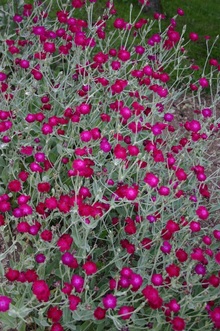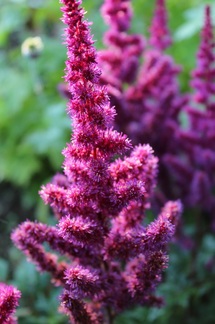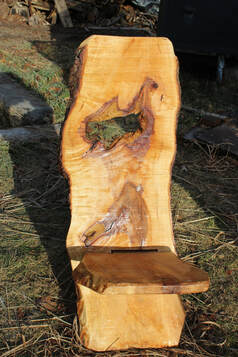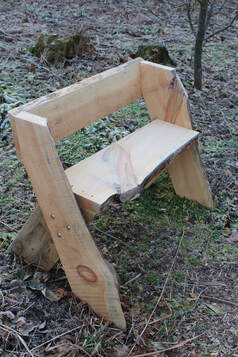I've been growing and selling perennials for about 37 years, with a short hiatus doing landscaping. I started with seven or eight varieties, sold some extra divisions on a picnic table near the road, and went on from there. I now grow 3 or 400 varieties. I've tried many others that I've given up on for one reason or another, usually because of failure to reliably survive the winter, but sometimes because of pest or disease problems.
Because I propagate and grow almost all of the plants that I sell, I am able to charge only $7 for every 1 gallon nursery pot. They are called 'one gallon', although they don't hold a gallon of soil. I usually buy a few plants every year- trying some new varieties or replacing some tried and true plants that I've sold too many of.
If you visit other nurseries in May, you'll notice that many of their plants are much more advanced than mine - they buy plants that are shipped in from Florida or other warm climates, or the plants have been growing inside heated greenhouses for a month or two. Most large nurseries also pump their plants full of fast acting chemical fertilizers and PGR's-plant growth regulators. Seems crazy to me.
I garden completely organically. I have never found a reason to use chemical fertilizers- I incorporate large amounts of my own compost into the soil each year, along with some from the Benson Farm. I use ramial wood chips for walkways and between rows, add wood ashes and biochar from my boiler, practice crop rotation and utilize cover crops where I can. In essence, I FEED THE SOIL.
I also feel very strongly about pesticides, herbicides and fungicides. In the 50+ years that I've been gardening with flowers, vegetables, and fruit, I've seen that organically grown, healthy plants have few disease and pest issues. By walking through the garden frequently and making close observations, one can often find and identify problems early and deal with them safely. If I find a few aphids on a particular plant, and I notice that there is a ladybug or lacewing larva feeding on them, I will leave them alone. If there is a large number of aphids in a group, I will spray them with a water and dish soap mix, very safe and non-toxic - but it will kill aphids. I very occasionally use NEEM, horticultural oil, or another organically approved product, any of which will break down rapidly into harmless substances. I often spend 12 or more hours a day in the garden seven days a week- even if I were to selfishly ignore the birds, toads, bees, butterflies and other co-inhabitants of my garden, why would I want to spread a toxic poison where I'm going to be working and breathing?
As Rachel Carson wrote in Silent Spring, "How could intelligent beings seek to control a few unwanted species by a method that contaminated the entire environment and brought the threat of disease and death even to their own kind?”
Watering
Established perennials do not need to and should not be watered every day. Daily watering encourages the plants roots to stay small and near the surface, when they should be spreading deep and wide. A thorough once a week watering during the growing season, if there is no rainfall, is, in most cases, more than adequate. Newly planted perennials and those in containers will need more frequent watering.
Sun and shade
When a plant is said to require full sun, that ordinarily means six hours of sunlight or more per day. Part sun and part shade means less than six hours, but nothing is set in stone. A plant that is said to need full shade can easily grow in four or five hours of sunlight- in fact, many shade plants will perform better with several hours of sun light, especially morning sun. A plant that is growing in partial shade will often flower longer than the same plant growing in full sun. For a plant like Bee Balm, Monarda didyma, whose blossoms I enjoy as much as the hummingbirds do, I usually have several patches of it, one in full sun, one in half sun, and one in limited sunlight, so that I (and the hummers and bees) have an extended period of bloom for a long time in summer.
My potting mix- has changed a bit over the years due to availability and reliability of source materials. For the past few years I've been making it out of 4 main ingredients plus 2 minor ones. I use a mixture of topsoil, well aged bark mulch, aged wood chips, and Surf'n'Turf organic compost from the Benson Farm in Gorham. I also add wood ashes and biochar from my wood boiler. The wood ashes add potassium, trace minerals and increase the PH a bit. Biochar is small pieces of half burned wood that is a long stable carbon source benefiting plants, soil biology including mycorrhizae, and the earth.
Because I propagate and grow almost all of the plants that I sell, I am able to charge only $7 for every 1 gallon nursery pot. They are called 'one gallon', although they don't hold a gallon of soil. I usually buy a few plants every year- trying some new varieties or replacing some tried and true plants that I've sold too many of.
If you visit other nurseries in May, you'll notice that many of their plants are much more advanced than mine - they buy plants that are shipped in from Florida or other warm climates, or the plants have been growing inside heated greenhouses for a month or two. Most large nurseries also pump their plants full of fast acting chemical fertilizers and PGR's-plant growth regulators. Seems crazy to me.
I garden completely organically. I have never found a reason to use chemical fertilizers- I incorporate large amounts of my own compost into the soil each year, along with some from the Benson Farm. I use ramial wood chips for walkways and between rows, add wood ashes and biochar from my boiler, practice crop rotation and utilize cover crops where I can. In essence, I FEED THE SOIL.
I also feel very strongly about pesticides, herbicides and fungicides. In the 50+ years that I've been gardening with flowers, vegetables, and fruit, I've seen that organically grown, healthy plants have few disease and pest issues. By walking through the garden frequently and making close observations, one can often find and identify problems early and deal with them safely. If I find a few aphids on a particular plant, and I notice that there is a ladybug or lacewing larva feeding on them, I will leave them alone. If there is a large number of aphids in a group, I will spray them with a water and dish soap mix, very safe and non-toxic - but it will kill aphids. I very occasionally use NEEM, horticultural oil, or another organically approved product, any of which will break down rapidly into harmless substances. I often spend 12 or more hours a day in the garden seven days a week- even if I were to selfishly ignore the birds, toads, bees, butterflies and other co-inhabitants of my garden, why would I want to spread a toxic poison where I'm going to be working and breathing?
As Rachel Carson wrote in Silent Spring, "How could intelligent beings seek to control a few unwanted species by a method that contaminated the entire environment and brought the threat of disease and death even to their own kind?”
Watering
Established perennials do not need to and should not be watered every day. Daily watering encourages the plants roots to stay small and near the surface, when they should be spreading deep and wide. A thorough once a week watering during the growing season, if there is no rainfall, is, in most cases, more than adequate. Newly planted perennials and those in containers will need more frequent watering.
Sun and shade
When a plant is said to require full sun, that ordinarily means six hours of sunlight or more per day. Part sun and part shade means less than six hours, but nothing is set in stone. A plant that is said to need full shade can easily grow in four or five hours of sunlight- in fact, many shade plants will perform better with several hours of sun light, especially morning sun. A plant that is growing in partial shade will often flower longer than the same plant growing in full sun. For a plant like Bee Balm, Monarda didyma, whose blossoms I enjoy as much as the hummingbirds do, I usually have several patches of it, one in full sun, one in half sun, and one in limited sunlight, so that I (and the hummers and bees) have an extended period of bloom for a long time in summer.
My potting mix- has changed a bit over the years due to availability and reliability of source materials. For the past few years I've been making it out of 4 main ingredients plus 2 minor ones. I use a mixture of topsoil, well aged bark mulch, aged wood chips, and Surf'n'Turf organic compost from the Benson Farm in Gorham. I also add wood ashes and biochar from my wood boiler. The wood ashes add potassium, trace minerals and increase the PH a bit. Biochar is small pieces of half burned wood that is a long stable carbon source benefiting plants, soil biology including mycorrhizae, and the earth.
Lychnis coronaria Stylophorum diphyllum Astilbe "Visions in Red"
(Rose Campion, Mullein Pink) (Celandine Poppy)
(Rose Campion, Mullein Pink) (Celandine Poppy)




